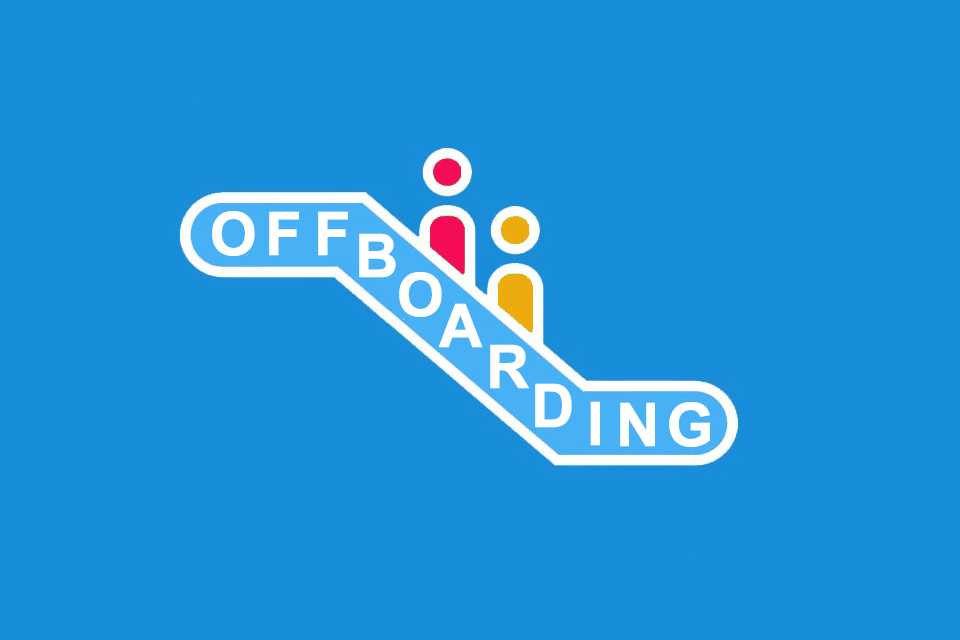What is Offboarding?
Offboarding – the structured parting of employees
The parting of employees or the change of employers is the rule rather than the exception in the course of a professional life. Consequently, onboarding and offboarding are the norm rather than the exception. Onboarding is the process of welcoming and integrating new employees into an organisation. Offboarding describes the structured process of parting employees who have worked for an organisation. “Letting someone get off board” is the inverse of “taking someone on board”.
Offboarding is often referred to in the context of
- outplacement,
- staff layoffs or
- exit management.
In contrast to onboarding, however, it is not about the speedy and most effective induction of new workers and is thus about a kind of investment protection, but about a sensible and also smooth separation of the parties involved. Moreover, it should also provide valuable input for future onboarding. Questions like
- What are the reasons for the separation?
- What can the organisation do better in the future?
- How can a more accurate position description, better staff selection or better onboarding be achieved?
- Or what would have to happen for you to want to work for us again?
can actively help in the further development of organisations.
Offboarding as an opportunity
Yes, offboarding can be an opportunity for all involved. In many organisations, however, this opportunity does not exist, because in a great number of cases the separation from or by employees goes hand in hand with offenses, rejections, hurt feelings, misunderstandings, etc. Of course, even in such cases it makes sense to seek honest dialogue in order to find out the causes of the mismatched expectations.
However, it is understandably not always easy for the parties involved to keep the big picture in mind in order to get the best out of such a situation for everyone. Offboarding can therefore be an opportunity that cannot always be seized in practice.
Offboarding phases
Onboarding can be divided into four types (formal, professional, social and cultural) and three phases (preboarding, orientation and integration). Theoretically, the types and phases of onboarding can also be used as structuring aspects in offboarding, but in practice a distinction is usually made between two alternative types or processes:
- the technical or systematic and
- the socio-emotional process.
The technical process addresses systematic aspects of the separation, such as
- the verbal and written termination,
- the clarification of parameters (last day of work, holiday and overtime entitlements, continued payment of wages, possible profit, turnover or company shares, possible severance pay, non-disclosure or non-competition agreements, the rights to one’s own image, etc.),
- the transfer of work materials (laptop, access cards, company keys, company car, fuel card, company credit card, etc.),
- the blocking or deletion of user accounts in various systems (e.g. access to mail systems, CRM, storage systems, development environments, networks, etc.) or the joint change of passwords, the redirection of telephone numbers and e-mail addresses, etc.
- the transfer of data from individually used work devices (laptops, mobile devices) to central systems,
- the reuse of work equipment and materials, or
- if applicable, the notification of indirectly affected areas (car park management, canteen, etc.).
Areas such as the specialist department, the HR department, the IT department, the accounting department and in some cases the legal department are usually involved in the systematic process.
In offboarding as a socio-emotional process, the focus is on people. For example, it is about
- the exchange of information on the reasons for the separation and unfulfilled expectations, as well as the identification of lessons learned in dialogue with the HR department, superiors and colleagues,
- internal and external communication including a justification of the separation,
- the transfer of knowledge and meaningful documentation of knowledge, as well as
- if necessary, the provision of a coach during the period of separation, both for the employee who is leaving the company and for the colleagues who will have to manage without the team member or colleague from now on.¹
The concrete walk-out (ideally including a thank-you note and, if applicable, gifts from the employer and/or colleagues) is also part of the socio-emotional process.
Opinions vary as to whether testimonial writing is understood more as a systematic or social task. Offering to be available as a reference for future employers or employees (depending on the reason and situation of the individual separation) is clearly part of the socio-emotional process and of course only works if the separation goes as smoothly as possible.
Reasons for offboarding
Why is structured offboarding important? Here are some reasons:
- It ensures that all tasks in the course of the process (formal aspects, return of work materials, preparation of a benevolent employer’s reference, feedback, etc.) are addressed and taken care of.
- It improves cooperation (and possibly motivation) in the case of a necessary transfer of knowledge.
- It is evidence of mutual appreciation if the termination of a cooperation receives similar attention as the beginning of a cooperation. And this contributes to a good relationship despite separation (and probably does no harm in employer evaluations on the internet after the end of cooperation).
- Returning work materials and blocking access closes or minimises security gaps and risks before they arise.
- It is an element of corporate culture and pays dividends to the company’s reputation.
And last but not least: it can be the basis for later reboarding; employees start working for the former company again after an interim intermezzo.
Impulse to discuss
At what point is it advisable to use a coach – possibly also an external one – for offboarding?
Notes:
[1] Again and again one hears how valuable it is for companies when a coach talks to employees who have resigned. In this way, valuable experiences and insights come to light and this can also be one of the many reasons why both sides later find their way back together.
There is also offboarding in software development. This offboarding takes place at the end of each development (and the end of the service agreement) by a development partner and follows the handover and acceptance of a realised solution.
Here you can find a German video with 7 steps in offboarding.
Here you can find a free offboarding checklist for download.
If you like the article or would like to discuss it, please feel free to share it in your network. And if you have any comments, please do not hesitate to send us a message.
Here you will find additional information from our t2informatik Blog:



